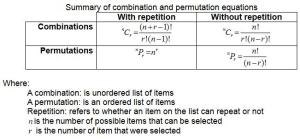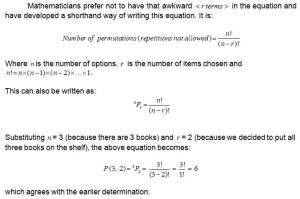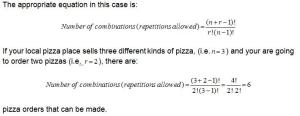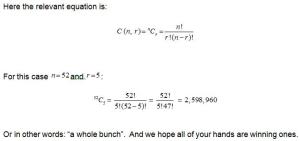Combinations and Permutations How many different poker hands are there? How many different pizza orders can be made? How many different ways can this work schedule be filled out? How many different ways are there to arrange your books in a bookshelf? These are all examples of combinations and permutations. And knowing how to calculate them is a helpful tool for decision making. The basic equations are: .  Permutations (with repetitions) Example: How many different ways can this work schedule be filled out? This is very straightforward. Suppose there are three operators (i.e. n equals 3) who have to cover of two shifts (i.e. r equals 2), then 9 possible work schedules that can be created.
Permutations (with repetitions) Example: How many different ways can this work schedule be filled out? This is very straightforward. Suppose there are three operators (i.e. n equals 3) who have to cover of two shifts (i.e. r equals 2), then 9 possible work schedules that can be created.
| Shift 1 | Shift 2 | |
| 1 | A | A |
| 2 | A | B |
| 3 | A | C |
| 4 | B | A |
| 5 | B | B |
| 6 | B | C |
| 7 | C | A |
| 8 | C | B |
| 9 | C | C |
The number of permutations is simply:  Permutations (without repetitions) Example: How many different ways are there to arrange your books in a bookshelf, if you have 3 books (called A, B, and C)? Again this is a straightforward question. it is easy to quickly determine that the correct answer is 6. For the first book, there are three choices, for the second there are only two choices and only one choice for the last choice. So the total number of permutations in this case is This simple example gives insight into constructing the equation for the general case. For the first choice there are options, for the second choice there are options, and this process repeats times. This can be written as:
Permutations (without repetitions) Example: How many different ways are there to arrange your books in a bookshelf, if you have 3 books (called A, B, and C)? Again this is a straightforward question. it is easy to quickly determine that the correct answer is 6. For the first book, there are three choices, for the second there are only two choices and only one choice for the last choice. So the total number of permutations in this case is This simple example gives insight into constructing the equation for the general case. For the first choice there are options, for the second choice there are options, and this process repeats times. This can be written as: 
 Combinations (with repetitions) Example: How many different pizzas can be made? Assuming that are n different kinds of pizza and you are ordering r pizzas.
Combinations (with repetitions) Example: How many different pizzas can be made? Assuming that are n different kinds of pizza and you are ordering r pizzas. 
| The six pizza orders (pizza pies come in flavors A, B, or C) that can be made with two pies are: | |
| A | A |
| A | B |
| A | C |
| B | B |
| B | C |
| C | C |
Combinations (without repetitions) Example: How many different poker hands are there? Here the relevant equation is: 
